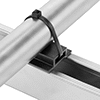Filter by
Rail Height
Material
Color
Bracket Type
T-Slotted Framing Component
Finish
DFARS Specialty Metals
Rail Width
Single Rail Profile Style
Strut Channel Framing Component
Framing Type
Most Likely Products
All Results
Containers, Storage, and Furniture
Building and Machinery Hardware
Measuring and Inspecting
Fastening and Joining
Electrical
































































































































